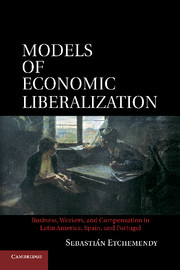 Models of Economic Liberalization
Models of Economic Liberalization Book contents
- Frontmatter
- Contents
- Acknowledgments
- Part I The Intellectual Terrain
- Part II The Political Economy of Business Adjustment
- Part III The Political Economy of Labor Adjustment
- 6 Compensating Labor Insiders
- 7 Statist and Corporatist Models of Labor Adjustment in Spain and Argentina
- Part IV The Market Model
- Part V Comparative Perspectives in Ibero-America
- 10 Conclusions
- Appendix
- Bibliography
- Index
6 - Compensating Labor Insiders
The Origins of Statist and Corporatist Models in Spain and Argentina
from Part III - The Political Economy of Labor Adjustment
Published online by Cambridge University Press: 07 October 2011
- Frontmatter
- Contents
- Acknowledgments
- Part I The Intellectual Terrain
- Part II The Political Economy of Business Adjustment
- Part III The Political Economy of Labor Adjustment
- 6 Compensating Labor Insiders
- 7 Statist and Corporatist Models of Labor Adjustment in Spain and Argentina
- Part IV The Market Model
- Part V Comparative Perspectives in Ibero-America
- 10 Conclusions
- Appendix
- Bibliography
- Index
Summary
Introduction
On November 23, 1984, Pablo González Larrazábal, a worker from the Spanish shipyard Euskalduna, was killed in Bilbao amid clashes between the police and union-led protesters opposing the government’s decision to close down the yard. Another worker was wounded by a police bullet, and a third seriously burned as a consequence of the riots. A few days before, in what some local newspapers called “an urban guerrilla exercise,” workers from the same plant had tried to seize Bilbao’s major banks and had occupied the Basque television station, forcing it to air their demands. In early 1984, as part of what came to be known as the “Battle of Sagunto,” steelworkers almost cut off the city of Valencia from the rest of Spain by occupying the airport and the train station and by setting up blockades in the main highways. But massive industrial conflict during economic liberalization and labor restructuring in Spain was not restricted to Euskalduna and Sagunto; nor was it limited to the early 1980s. During the adjustment period 1982–88, there were more strikes, and more workers participated in strikes, than in any other period since the civil war (Wozniak : 2), and Spain consistently ranked at the top of strike activity in the European Union until 1995.
In Argentina, by contrast, no major industrial conflict arose during the heyday of market reform and industrial adjustment in the 1990s. No significant riots took place, either in populated urban areas similar to Bilbao or in company towns that were decimated by downsizing and unemployment. Big sectoral strikes were sporadic and generally faded away before they had gathered momentum. Widespread popular mobilization would only reemerge in the late 1990s, in the postadjustment period. However, it would take the form of street protest by the organizations of the unemployed rather than industrial action.
- Type
- Chapter
- Information
- Models of Economic LiberalizationBusiness, Workers, and Compensation in Latin America, Spain, and Portugal, pp. 153 - 188Publisher: Cambridge University PressPrint publication year: 2011


